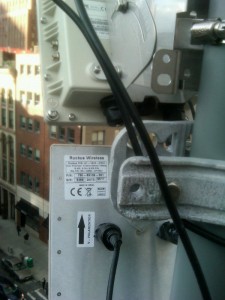Nosy Neighbor: Gizmo Update
Last week I posted A.’s question about the gizmos on the roof of 65 Reade (and 78 Reade and 122 Duane). We had three theories: vibration sensors, Wi-Fi transmitters, and microwave devices.
 Well, here’s a photo of one of the gizmos, taken by a helpful sleuth. You can click to enlarge, but you don’t really have to. The pertinent info on it is that it’s from a company called Ruckus Wireless. Sayeth the website: “Our claim to fame is on our patented Smart Wi-Fi technology and its unique ability to support streaming multicast IP video over the 802.11 standard protocol. This adaptive antenna technology leverages high-gain directional array technology and rocket-science best path selection algorithms to form and direct Wi-Fi signals over the best performing paths to each and every client.” Stop! You’re turning me on!
Well, here’s a photo of one of the gizmos, taken by a helpful sleuth. You can click to enlarge, but you don’t really have to. The pertinent info on it is that it’s from a company called Ruckus Wireless. Sayeth the website: “Our claim to fame is on our patented Smart Wi-Fi technology and its unique ability to support streaming multicast IP video over the 802.11 standard protocol. This adaptive antenna technology leverages high-gain directional array technology and rocket-science best path selection algorithms to form and direct Wi-Fi signals over the best performing paths to each and every client.” Stop! You’re turning me on!
I emailed David Callisch, the press contact at Ruckus. “It’s one of our Wi-Fi access points that Towerstream (I believe) has deployed for their wireless access service throughout Manhattan. Why?” I explained that they’re kind of funky-looking, seeing as how they point down toward the street. “Yeah,” he replied. “The devices themselves are quite small, relative to other (i.e. Cisco) boxes which are monsters. I think the thing that gets people’s attention is the antenna. Towerstream is, I believe, providing a free Wi-Fi service to people (for now). Have you tried to connect to the device?” Er, no…. “The Wi-Fi access points are actually special devices that focus Wi-Fi signals only where they are needed and are designed to steer signals around interference when it is experienced.”
This is from a Bloomberg Businessweek article on Towerstream, which Callisch sent over: “Imagine if smartphones always worked as fast as home Wi-Fi networks, and no one had to pray that a cellular signal was strong enough to send an e-mail or retrieve a map. A company called Towerstream hopes to make that dream come true for New Yorkers in late June, when it turns on a network of about 1,000 wireless routers—souped-up, weatherproof versions of the Wi-Fi devices in millions of homes. The goal […] is to provide a superfast mobile network that covers seven square miles of Manhattan, and sell access to the system to wireless carriers that can use it to fill in areas prone to spotty service.” There’s more. “Consumers may never know they’re using Towerstream’s network. Behind the scenes, Carrier X would seamlessly switch a customer’s smartphone or tablet to Wi-Fi mode when that person comes within range of one of Towerstream’s hotspots, and the connection speed would go up dramatically. During a demonstration recently on the corner of West Broadway and Broome Street in New York’s SoHo district, an iPhone’s data speed leapt from .35 megabits per second to 26 Mbps. That’s fast enough to stream high-def video, and much faster than most home connections in the U.S.”
And this! “The antennas themselves are much cheaper and less obtrusive than cell towers. They’re about the size of a football, cost about $800 apiece, and sit on poles or rooftops; cell towers can run upwards of $200,000. Towerstream representatives have fanned out in Manhattan, persuading landlords and building owners to let the company install the devices on their property. The company pays $50 to $1,000 per installation per month, depending on location.” Love the range!!! Hold out for the big bucks, folks!
I believe we can declare this Nosy Neighbor case closed. (Although it may reopen once these things start popping up in landmarked districts. Wait, that block of Reade is landmarked….) Thanks to everyone who helped solve it.












